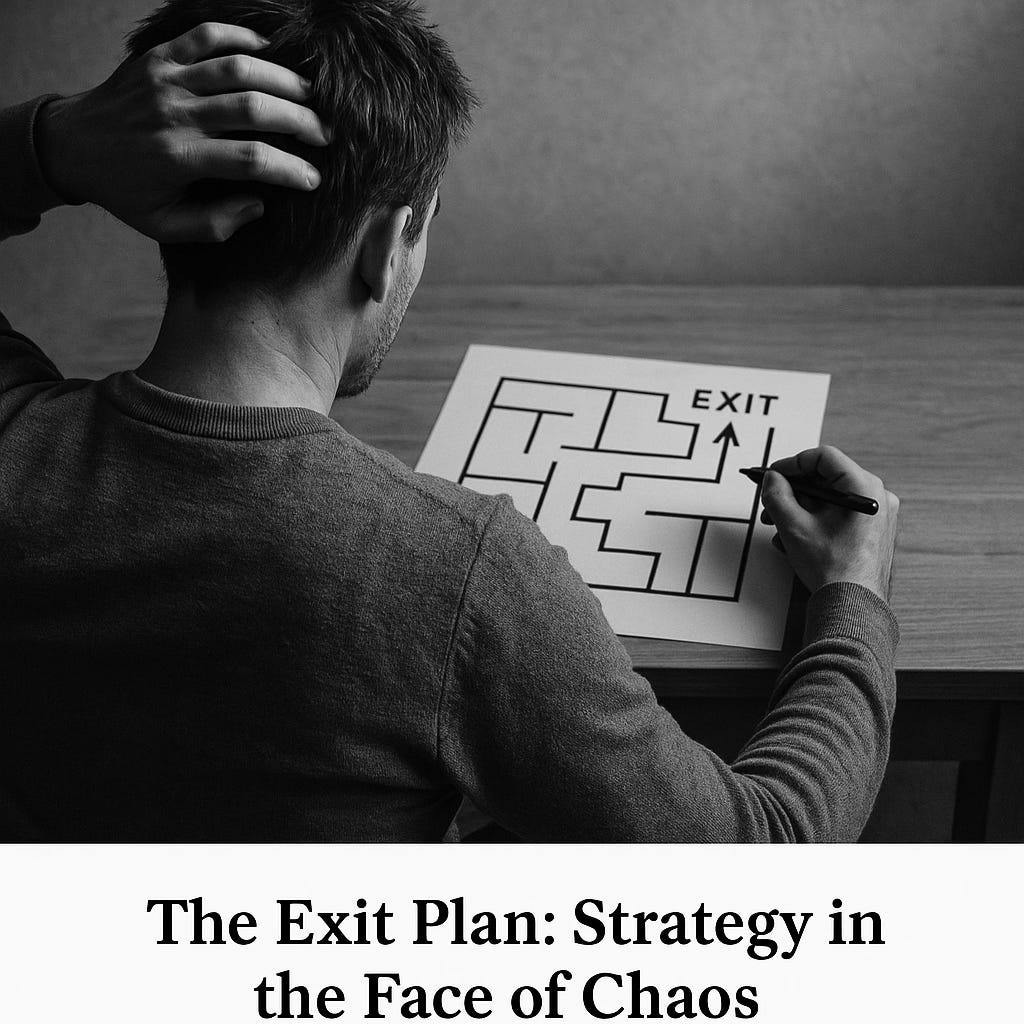Chapter 4 - The Exit Plan: Strategy in the Face of Chaos
From THX Series Hub: The Narcissist’s Playbook & The Life After
Healing After Narcissism
(Framed by the THX Framework and the Predictability of the Narcissist Playbook)
Author’s Note: This post includes reflections on covert planning, surveillance, medical trauma, and navigating the legal system during an emotionally abusive separation. Please take care as you read.
People imagine leaving a narcissist looks like a bold, sudden act.
Packing bags. Walking out. Slamming doors.
But that’s not how it works when you’re trying to protect your children, stay alive, and outsmart someone who is both manipulative and legally advantaged.
Leaving a narcissist is not a moment. It’s a strategy.
And mine began long before I said the words: “I want to separate.”
I Had Tried the System. It Failed Me.
I tried to get an order of protection.
But her attorney twisted my words. And I had no lawyer.
The ones I consulted warned me:
“You’ll likely lose—not because you don’t have a case, but because this court almost always sides with the mother unless the evidence is overwhelming and incontrovertible.”
The female magistrate told me to my face:
“Unless you have a recording of her admitting what she’s done, there’s nothing I can do.”
It was crushing.
But in hindsight, not getting that order may have saved my daughters.
Because without a court-mandated custody arrangement, they were allowed to stay with me—and not be forced into time with their mother.
So I adapted.
I went silent.
And I began to watch. Learn. Record. Prepare.
I Knew Her Patterns. And I Knew the Playbook.
She began listening in on my business calls. I found notes she took.
She hid on the stairs to eavesdrop on my conversations with friends.
Eventually, I started driving to a dark parking lot just to speak freely.
I was sleeping on the sofa by then—by choice. For safety.
She had triggered my anaphylactic reactions more than once by using essential oils while I slept.
I set up a nanny cam because I’d wake up to her standing over me. Watching me.
Sometimes sitting next to me in silence.
I recorded nearly everything.
Because now I understood:
I was playing a long game. And I needed documentation, not confrontation.
I Planned My Exit With Precision
I sought legal advice behind the scenes.
We needed to sell our 19-year-old home.
I convinced her, calmly, logically, that it was time. She agreed.
Only after the process was underway did I tell her:
“I want to separate.”
That was when it all escalated.
She tried to find out where I was moving.
She assumed the girls were going with me—and she wanted to live in the same apartment complex.
She didn’t want the responsibility.
She didn’t offer financial support for months.
Eventually, she agreed to set aside a small portion of the home proceeds for the girls’ expenses. It didn’t come close.
But I didn’t argue.
I’d stopped expecting fairness.
I wanted freedom.
We Lived in Hiding, and She Never Found Us
She never knew where we lived.
I let her send packages to the girls through a mailbox service.
We met a few times in Target parking lots—public, with cameras.
Even then, she sent things that triggered my anaphylaxis.
She also sent things the girls were allergic to.
Whether carelessness or malice—I stopped trying to decide.
I found us a new home.
A gated apartment complex with security. Cameras. Peace.
Somewhere beautiful. Safe. Out of her price range.
Because I knew she couldn’t help herself—she would blow through her money, and she did.
The divorce discovery showed it:
$500–$1000 a month on clothes.
Spa visits. Bar tabs. Retail therapy.
Meanwhile, I was funding tuition, covering mounting medical bills, and driving my daughter to appointments three times a week.
And I never complained.
Because I didn’t need revenge.
I needed recovery.
The Cost I Chose Will Always Be Worth It
I accepted all the responsibility.
I wanted my daughters to heal.
To feel safe.
To know that I stayed as long as I did to try to give them something resembling stability.
They saw the truth.
They saw her trigger my reactions and stand by.
They saw me nearly die.
They stayed up to protect me.
My oldest formed the habit of waking at 2am each night—just to make sure I was still breathing.
In the final months, she tried to seduce me. I said no.
Two months after we separated, she claimed she had been pregnant by me and miscarried before I moved out.
But her story unraveled.
She hadn’t taken time off work. Showed no symptoms. Told no one.
Not even her twin sister—who knew everything else.
I had the recording. I had the contradictions.
And I had the clarity.
This Was Not Just an Escape. It Was a Liberation.
I didn’t just leave.
I navigated a minefield.
With strategy. With silence. With documentation.
With unwavering focus on one outcome: safety for me and my daughters.
Next, I’ll share what life looked like after escape—how we lived, healed, and found freedom in the small, sacred micro-moments that follow surviving.
Reflection Prompt
If you couldn’t escape all at once, how would you begin to reclaim small pieces of your power—quietly, strategically, consistently?
What’s one thing you can control right now?

Interpretation: The black-and-white imagery and maze-like plan reflect the complexity of leaving a narcissistic relationship. This is not a spontaneous act of rebellion—it’s the careful architecture of liberation, strategy forged in silence, and survival masked as routine.



